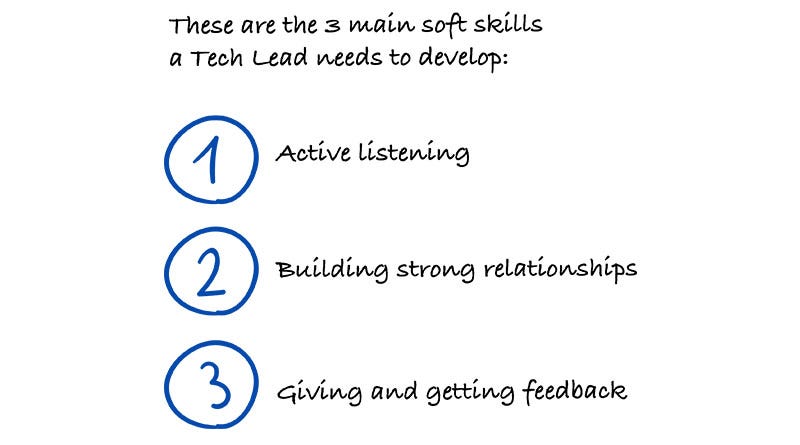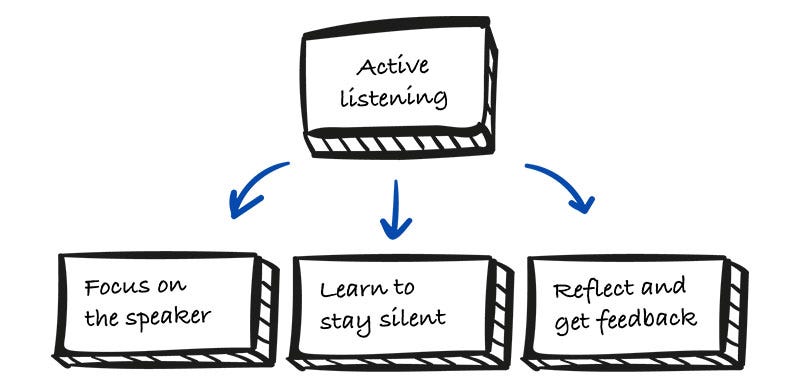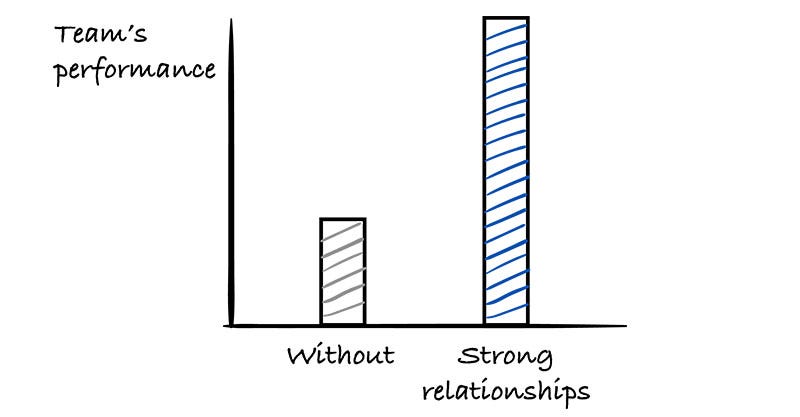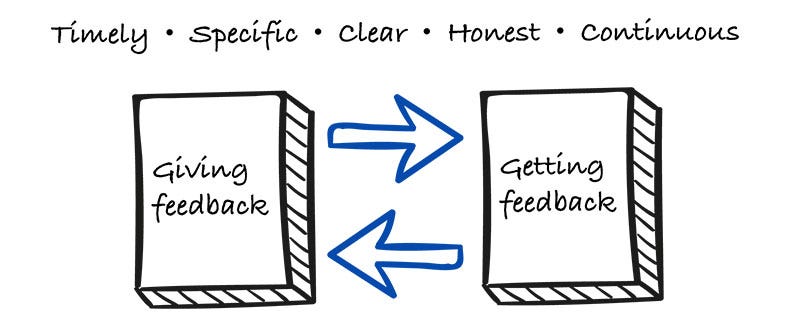3 main soft skills a Tech Lead needs to develop
- Gregor Ojstersek and Anemari Fiser from Engineering Leadership <gregorojstersek@substack.com>
- Hidden Recipient <hidden@emailshot.io>
3 main soft skills a Tech Lead needs to developBecome a great Tech Lead by focusing on these 3 main soft skills!Rask AI (sponsored)This week's newsletter is brought to you by Rask AI that increases speed to market for authentic content localization and enables new growth opportunities through AI-powered translation and dubbing tools. Need to reach viewers worldwide? Your videos can now speak 130+ languages automatically. Rask AI handles everything – transcription, translation, dubbing, and lip-syncing – through one simple API integration. Exclusive for Engineering Leadership readers: Book a demo with them this week to claim a $500 welcome bonus. Let’s get back to this week’s thought! IntroAs engineers, we often want to dive headfirst into technologies. But time and time again, I’ve found that the real challenges aren’t in tech, they’re in:
This is especially important to understand for Tech Leads, who are leading various projects. The better they are in collaboration, communication and overall soft skills, the better the software will be produced as well. In today’s newsletter article, I am happy to team up with Anemari Fiser. Anemari is a former Tech Lead turned Coach, who especially focuses on helping Tech Leads to thrive in their roles. She is sharing 3 main soft skills a Tech Lead needs to develop based on her broad experience in the engineering industry. Anemari, over to you! Why you need soft skills as a Tech LeadAs a former Tech Lead at ThoughtWorks and having coached over 200 Tech Leads in the past three years, I’ve noticed a common misconception: most Tech Leads believe technical skills are all they need. I thought so too, until I stepped into the role and realized that the biggest challenges weren’t technical but people-focused like managing time, resolving conflicts, and growing individuals. For example, I once dealt with two developers arguing over a JSON library. My instinct was to dive into the technical options, but digging deeper revealed the real issue: a recurring personal conflict. By addressing their relationship instead of the library, I resolved the immediate issue and improved their collaboration. Another time, our team wasn’t tackling tech debt despite having the skills and buy-in. The real problem? A lack of ownership. Instead of taking over myself, I empowered a senior developer to lead, building their confidence and creating a sustainable solution. Through these experiences, I’ve learned that:
Solving them requires soft skills, not more technical expertise. Let’s go straight to the first one! 1. Active listening
This quote from Stephen R. Covey’s book The 7 Habits of Highly Effective People resonates deeply with me. When I look back at my early days, every time someone would come to me with a problem or story, I’d often catch myself thinking, “Oh, me too!” or “Let me tell you how I fixed that.” The problem? The moment I shifted the focus to me, I stopped truly listening. I was just waiting for my turn to talk, not giving the other person the attention they deserved. Learning to be a better listener has been one of my biggest personal growth areas. It’s not something that just happens - it takes intentional effort and practice. But like any skill, it can be improved with the right mindset and approach. Here are my key strategies that will help you become a better listener: Focus on the speakerOne of the simplest yet most powerful shifts is making the conversation about them, not you. To remind myself of this, I have a Post-it on my monitor that says, “This is not about me.” When I started working remotely, I found distractions harder to manage. Now, I use:
Learn to stay silent
Early in my career, I felt as a Tech Lead I needed to fill every silence or always have the final say. This stifled my team because they weren’t getting the space to share their ideas.
To fix this, I started defaulting to mute during meetings. One time, I forgot I was muted and kept talking while the team carried on without me. I was surprised to see them handling the discussion just fine! That moment taught me to trust my team more and step back.
Another trick that worked wonders: counting to 39 in my head during silences. If no one speaks by then (though someone almost always does), I step in. This simple strategy gave my team the chance to take ownership while breaking my habit of jumping in too quickly. Reflect and get feedbackReflection has been a game-changer. After key meetings, like 1-1s or feedback sessions, I set aside 15 minutes to reflect on questions like:
Feedback from others is equally important. I’ve learned a lot by asking questions like:
Remember:
2. Building strong relationshipsOne of the biggest factors that contributed to my team’s high performance was the relationships we built: within the team, with stakeholders, and with clients. Sure, it took time and energy to develop these relationships, but it was absolutely worth it as they made alignment easier, created a safe space for challenging ideas and sharing solutions, and ultimately drove great results. At the core of these strong relationships is trust. Trust doesn’t just happen; it’s built intentionally through two key elements: constant communication and transparency. Constant communication
One of my first moves as a Tech Lead on a new team is to set up recurring 1-on-1 with each team member. Sure, frequency might adjust, or we might skip one occasionally, but the point is: they’re there. This gives the team the confidence that you’re invested and will continuously show up for them.
Don’t just report on wins; keep stakeholders informed about blockers, challenges, and shifts in strategy.
If you’re the only one who knows something, it’s a problem. Proactively share information with your team and stakeholders to ensure everyone is aligned and informed. Transparent communication
Trust starts with doing what you say you’ll do. If something changes, inform your team or stakeholders early so they can adapt.
Another way to build trust is by giving both positive and constructive feedback. It takes courage to be open about areas for growth, but this balanced approach shows genuine investment in others' development. Breaking the iceA common challenge for Tech Leads in building relationships is breaking the ice. It can feel awkward at first, but here are some practical tips to help ease into conversations and create connections.
After a presentation, say, “I really liked your point about…”; being specific makes all the difference! Jot down one detail that resonates.
Reach out to someone tackling a similar project and say, “I heard you’re working on... Mind sharing how you approached <x>?”
A simple “I heard you’re the person to talk to about…” can open doors, even if they can’t directly help.
Avoid “hello” with no context: knowing what they are getting themselves into increases the chance of people replying.
If someone invites you for coffee or a casual chat, join.
Respond to those Slack questions that go unanswered. Even tagging someone who might know shows you’re supportive, which others notice.
Host a showcase, lead a meeting, or offer a Q&A session. It’s an easy way to start building connections without having to reach out yourself – you’re creating a space where they can approach you. 3. Giving and getting feedbackFeedback is one of the most powerful tools for growth, but many Tech Leads find it challenging. Here are some ground rules for giving effective feedback:
Frequent feedback makes it easier. Don’t wait for formal reviews! ❌ Someone presents a wrong diagram → Don’t ignore it. Instead, schedule a private call soon to discuss. ✅ Someone nails a presentation → "Loved how you explained the diagram, clear and concise!"
❌ “You’re always late.” ✅ “You were late to Standup this morning.”
❌ “I think you might’ve said the wrong thing.” ✅ “In Standup, you said 3 services need integration, but it’s actually 2. That created confusion as we already communicated 2.”
Don’t force compliments if you don’t have any. People can tell when feedback isn’t genuine.
Feedback isn’t a one-off. Follow up to check progress and show support. Feedback challenges for Tech LeadsTech Leads often face two main challenges when it comes to feedback:
Use the SBI model to structure feedback: describe the Situation, the observed Behavior, and its Impact. This approach focuses on facts and personal statements (e.g., “I felt disappointed”), making feedback easier to give and receive without triggering defensiveness. Last wordsSpecial thanks to Anemari for sharing her insights on this very important topic! Make sure to follow her on LinkedIn and check out her newsletter Level up as a Tech Lead. Anemari also has a course, where she dives deeper into all 7 essential soft skills for Tech Leads, check out her course here: Soft Skills for Tech Leads O’Reilly online course. We are not over yet! How teaching made me a better engineer and managerCheck out this week’s newsletter for paid subscribers. I’ve shared my story how teaching made me a better engineer and manager throughout my career. Senior Engineer to Lead: Grow and thrive in the roleStart 2025 in the right way and secure your spot in Jaunary’s cohort! In the cohort-based course, we particularly focus on the development of much needed people / communication and leadership skills in order to grow from engineer to leader! Join engineers and leads from Meta, Google, IBM, Revolut in the cohort-based course here: Looking forward to seeing some of you there. Liked this article? Make sure to 💙 click the like button. Feedback or addition? Make sure to 💬 comment. Know someone that would find this helpful? Make sure to 🔁 share this post. Whenever you are ready, here is how I can help you further
Get in touchYou can find me on LinkedIn or Twitter. If you wish to make a request on particular topic you would like to read, you can send me an email to info@gregorojstersek.com. This newsletter is funded by paid subscriptions from readers like yourself. If you aren’t already, consider becoming a paid subscriber to receive the full experience! You are more than welcome to find whatever interests you here and try it out in your particular case. Let me know how it went! Topics are normally about all things engineering related, leadership, management, developing scalable products, building teams etc. You're currently a free subscriber to Engineering Leadership. For the full experience, upgrade your subscription. |
Similar newsletters
There are other similar shared emails that you might be interested in:






